I recently became hooked on watching the Netflix series “Alpha Males“ and listening to the very loosely related excellent 2022 book by Richard Reeves “Of Boys and Men: Why the Modern Male Is Struggling, Why It Matters, and What to Do“, which President Obama put on his top 10 book list for 2022, and David Brooks and Michelle Goldberg called one of the most important books of the year in their respective NYT columns. (Contact me if you can’t access the NYT articles and I can gift you an access link.)
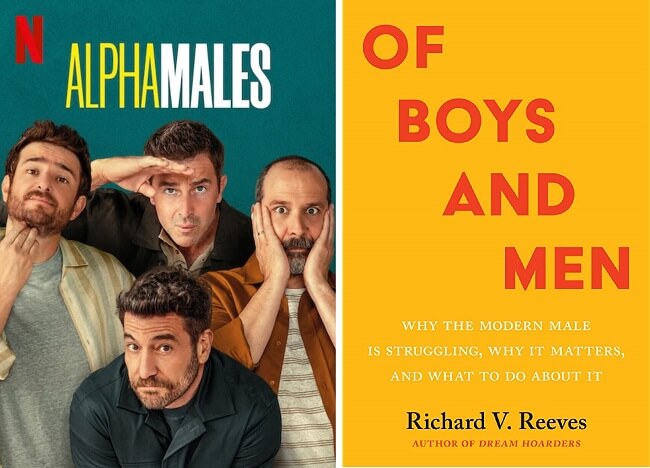
Both, Alpha Males and Of Boys and Men describe the challenges that many men face but don’t offer Integral solutions that you find at the end of this post and that we explore in the 26 Modules of our Practice Groups, Trainings, Workshops, Consultations, and Movie “Nights”.
In Alpha Males, we see four male friends with various levels of “toxic” masculinity struggling in their live and love relationships with female partners of various levels of femininity and motherhood.
In the first part of Of Boys and Men, Reeves provides a staggering amount of sex, gender, class, and race differentiated research and statistics how boys and men are falling increasingly behind in education, the workplace, as partners, and as fathers, as shown in the graphics below.
A few things stood out for me from his book:
1. Things are worse than Reeves thought:
– World-class scholars and Nobel Prize winning researchers have no theory why boys and men don’t take advantage or benefit from opportunities in ways that girls and women do (see pages 31, 99, 100, 102, Kindle Edition.)
– The gender gap in college degrees awarded is wider today than it was in the early 1970s.
– The wages of most men are lower today than they were in 1979, while women’s wages have risen sharply across the board.
– In 2014, more men aged 18-34 were living with their parents than with a wife or partner.
– One in five fathers are not living with their children.
– Men account for almost three out of four “deaths of despair,” either from a suicide or an overdose.
– Boys and men struggling most are those at the sharp end of other inequalities, especially of class and race.
– Men at the top are still flourishing, but men in general are not.
– The problems of boys and men are structural in nature, rather than individual; but are rarely treated as such.
– The problem with men is typically framed as a problem of men.
– Boys are falling behind at school and college because the educational system is structured in ways that put them at a disadvantage.
– Men are struggling in the labor market because of an economic shift away from traditionally male jobs.
– Fathers are dislocated because the cultural role of family provider has been hollowed out.
– Many social policy interventions only help women, for example college completion increasing by almost 50%, while men seem to experience zero benefit.
– Progressives refuse to accept that important gender inequalities can run in both directions, and quickly label male problems as symptoms of “toxic masculinity.”
– Conservatives appear more sensitive to the struggles of boys and men, but only as a justification for turning back the clock and restoring traditional gender roles.
– Across the world, men have been more likely than women to support right-wing or protest parties (including BREXIT).
– In 2020, Trump still won most of the male votes, and actually increased his support among Black and Latino men.
Taken together, this also becomes a problem for women who want to find adequate partners, and because disadvantaged men contribute less (or nothing) to families and societies, and potentially become radicalized, repressive, and violent/destructive.
2. Reeves argues that we need to support both sexes:
Many feminists and left-leaning politicians see any support for boys and men as an attack on girls and women.
Page 33: Melissa Kearney said: “I am really worried about the extent to which men in the U.S. are being pushed to the side of economic, social and family life. For 20, 30 or 40 years … scholars focused on women and children. Now we really need to think about men.”
Susan Faludi writes: “Many in the women’s movement and in the mass media complain that men just ‘don’t want to give up the reins of power’. But that would seem to have little applicability to the situations of most men, who individually feel not the reins of power in their hands but its bit in their mouths.”
3. The pay gap:
For the feminist Left, the pay gap proves patriarchy. Toni Van Pelt, president of the National Organization for Women: “The wage gap is a blatantly unfair vestige of a patriarchal labor system that haunts women’s economic potential throughout their lives.” Conservatives often dismiss the idea of a pay gap as a feminist myth, used to create the impression of inequalities that simply do not exist (Page 43).
Both are right if we differentiate by income and race, even though the pay gap has almost closed between 1979 and 2019 and only exists for low earners as we see below.
Page 44: The one-word explanation for the pay gap is: Children.
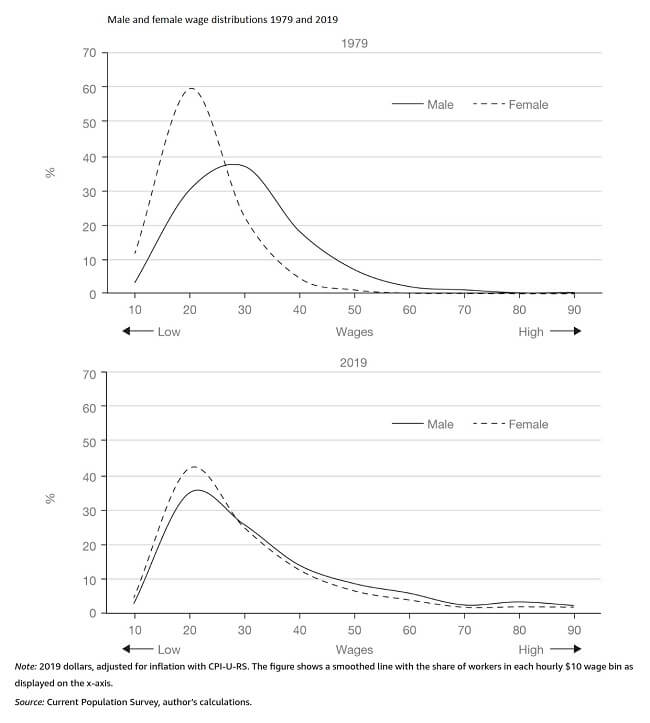
Image above: Male and female wage distributions 1979 and 2019, page 42
White women now earn more than black men and black women.
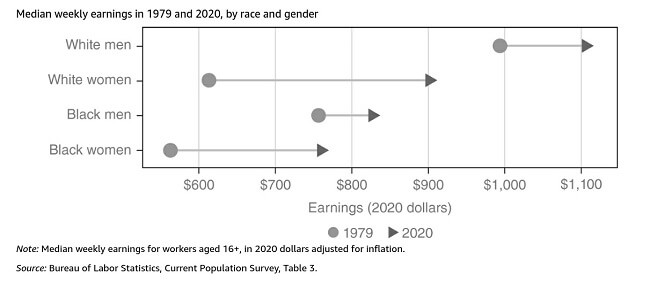
Image above: Median weekly earnings in 1979 and 2020, by race and gender, page 73
4. Education:
Girls earn better grades.
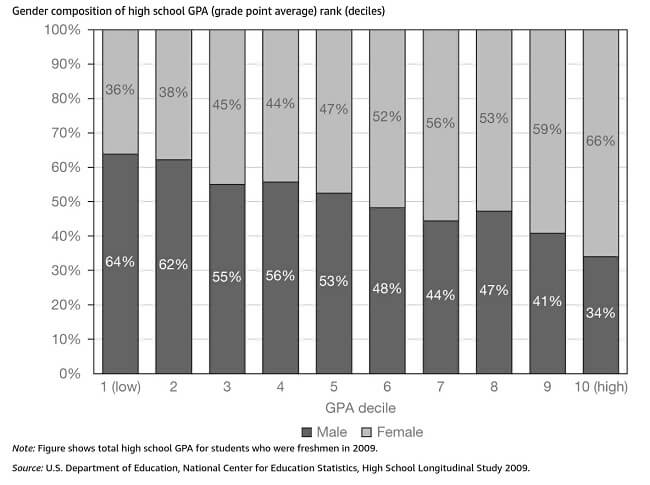
Image above: Gender composition of high school GPA (grade point average) rank (deciles), page 18
Boys and men fall back in education world-wide.
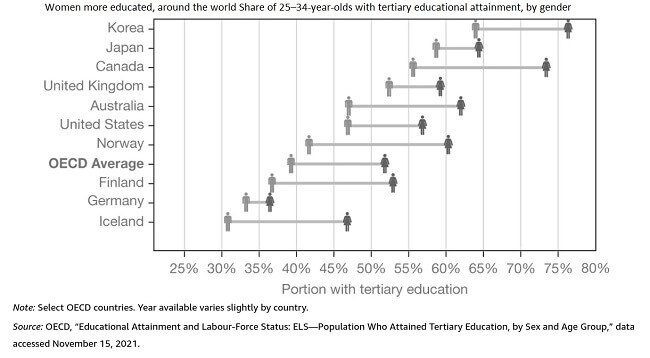
Image above: Women are more educated around the world, page 27
Women earn more degrees.
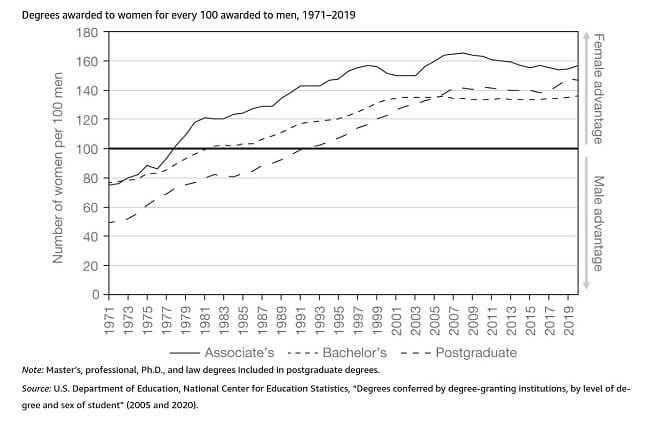
Image above: The great educational overtaking. Degrees awarded to women for every 100 awarded to men, 1971–2019, page 25
Black females earn 2/3 of degrees over black males.
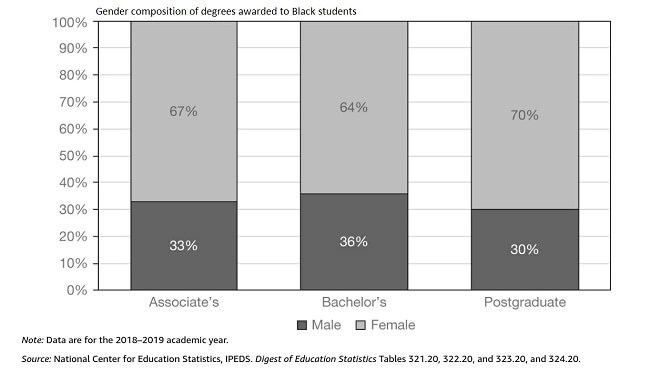
Image above: Black men lag Black women in education. Gender composition of degrees awarded to Black students, page 72
Gender of teachers by school level
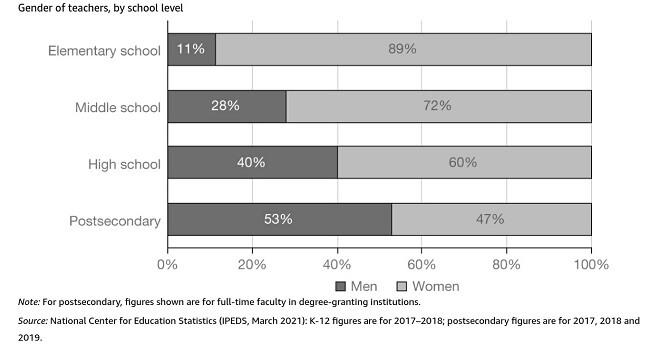
Image above: Gender of teachers, by school level, page 172
5. The Workplace:
In the past 40 years, employment of women has risen sharply while male employment has fallen.
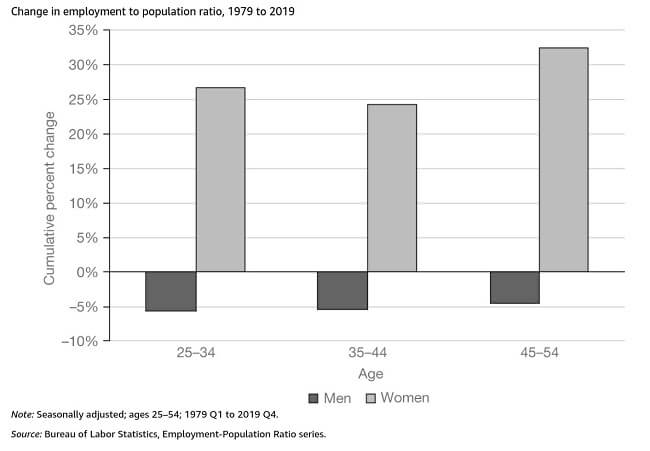
Image above: Change in employment to population ratio, 1979 to 2019, page 35
Increasing amount of women in select STEM fields.
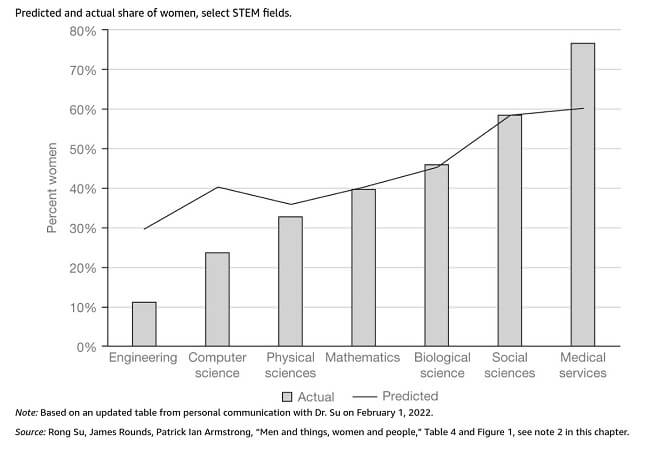
Image above: Sex differences in job interest and job choice. Predicted and actual share of women in selected STEM fields, page 128
Dramatically falling rates of males in HEAL occupations.
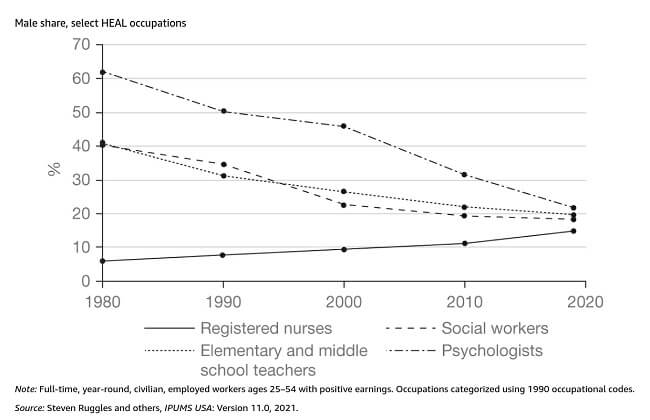
Image above: Male participation in select HEAL occupations 1980 – 2020, page 190
Share of workers in STEM and HEAL occupations by gender, 1980 and 2019.
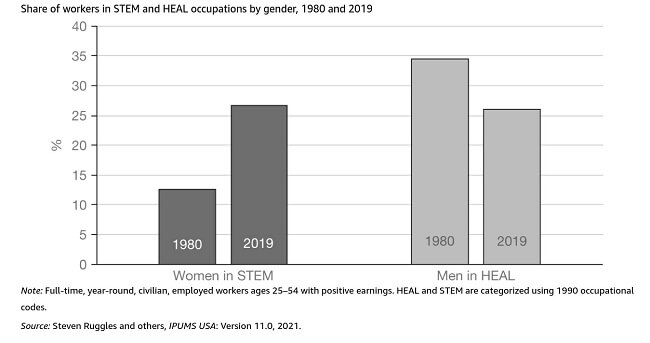
Image above: Women Rise in STEM, Men Fall in HEAL, page 186
Reeves offers the following solutions:
1. Start boys one year later in school than girls, as their brains develop later (he correctly differentiates sex and gender.)
2. Create a boy and male-friendly education system with more male teachers and career advisers of color.
3. Help men (and not only women) to move into professions in the growing fields of Health, Education, Administration, and Literacy, or “HEAL”.
4. Bolster fatherhood as an independent social institution.
5. Help men adapt to the dramatic changes of recent decades without asking them to stop being men.
6. Create a prosocial masculinity for a postfeminist world.
I suggest the following additional solutions:
1. Differentiate more clearly sex, gender, and healthy and unhealthy feminine and masculine polarities instead of simply differentiating boys/men and girls/women.
2. Stop conflating masculinity with male and support the development of healthy feminine and masculine polarities in both sexes instead of denouncing all masculinity as “toxic” while glorifying all feminine traits as positive, pure, and healthy.
3. Add relational skill development to the current school curriculum.
4. In addition to (or instead of) career counseling and focus on increasing earnings, support boys/men and girls/women in first identifying their natural talents and support related skill development so that they can live and share their biological, transformational, and transcendental purpose as adults in healthy relationships.
5. Educate teachers and helping professional about teaching healthy “Integral” relationship skills (Integral Relationship Practice) and healing complex developmental trauma (e.g. using NARM) and make therapy easily accessible to men and women and covered by health insurance.

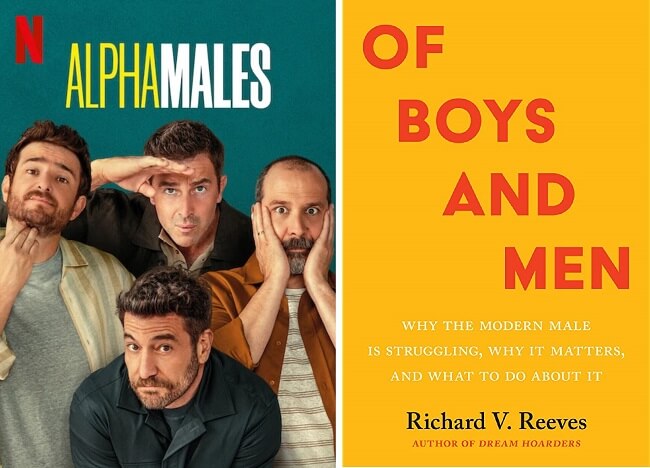
3mortgages